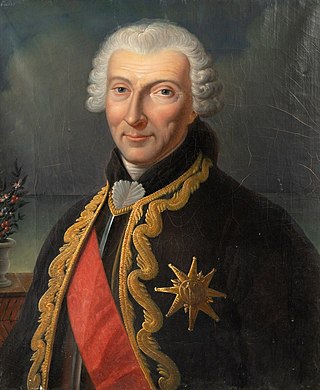
Coffee production in Martinique dates to 1723 and its establishment is credited to the French naval officer Gabriel de Clieu. It later spread to other places in the Caribbean and South America from Martinique, [1] an overseas region of France.

Coffee production in Martinique dates to 1723 and its establishment is credited to the French naval officer Gabriel de Clieu. It later spread to other places in the Caribbean and South America from Martinique, [1] an overseas region of France.
Jules Rossignon wrote that in 1723, Royal Physician Pierre Chirac gave Gabriel de Clieu, a French navy lieutenant, a coffee tree to be planted in Martinique.[ citation needed ] In spite of King Louis XV refusing permission to do so, de Clieu took a cutting from a coffee plant in the royal gardens during a night time burglary and planted it in Martinique. He gave the seeds to De la Guarigue-Survillier, colonel of the Martinique militia, and to other inhabitants of the island, who planted them.[ citation needed ] Clieu faced many challenges while transporting the coffee plant, including a pirate attack and an Atlantic storm. The glass box in which the plant was being carried broke; and when faced with water shortage during the voyage he shared his water ration with the plant. After finally reaching his destination, he planted the crop, which grew and in a few years, coffee plantations were established in the Martinique. [2] [3]
Coffee plantations proliferated in Martinique, with some 18 million coffee trees planted, [1] until the earthquake of November 7, 1727.[ citation needed ] The assiduity and perseverance of the settlers were such that this island produced by itself more coffee than was required for the consumption of the whole of France. From Martinique some coffee trees were sent to Santo Domingo, Guadeloupe, and other neighboring islands, and on to Central and South America. [4] [1]
According to the 2013 statistics of FAO, production of green coffee in the country was 25 tons from a cropped area of 30 ha with yield rate of 21,875 hectogram per ha. [5]
This is a page on the history of the island of Martinique.

The history of coffee dates back centuries in Ethiopia and Yemen. It was already known in Mecca in the 15th century. Also, in the 15th century, Sufi monasteries in Yemen employed coffee as an aid to concentration during prayers. Coffee later spread to the Levant in the early 16th century; it caused some controversy on whether it was halal in Ottoman and Mamluk society. Coffee arrived in Italy the second half of the 16th century through commercial Mediterranean trade routes, while Central and Eastern Europeans learned of coffee from the Ottomans. By the mid 17th century, it had reached India and the East Indies.

Gabriel-Mathieu Francois D'ceus de Clieu was a French naval officer and the governor of Guadeloupe from 1737 to 1752 and the founder of Pointe-à-Pitre. He was awarded the rank of commander of the Royal and Military Order of Saint Louis.
Nicaragua produces coffee, cotton, bananas, sugar and beef cattle.

Angola is a potentially rich agricultural country, with fertile soils, a favourable climate, and about 57.4 million ha of agricultural land, including more than 5.0 million ha of arable land. Before independence from Portugal in 1975, Angola had a flourishing tradition of family-based farming and was self-sufficient in all major food crops except wheat. The country exported coffee and maize, as well as crops such as sisal, bananas, tobacco and cassava. By the 1990s Angola produced less than 1% the volume of coffee it had produced in the early 1970s, while production of cotton, tobacco and sugar cane had ceased almost entirely. Poor global market prices and lack of investment have severely limited the sector since independence.

Coffee production in India is dominated in the hill tracts of South Indian states, with Karnataka accounting for 71%, followed by Kerala with 21% and Tamil Nadu. Indian coffee is said to be the finest coffee grown in the shade rather than direct sunlight anywhere in the world. There are about 250,000 coffee growers in the country; 98% of them are small growers. As of 2009, Indian coffee made up just 4.5% of the global production, being the 7th largest producer of coffee. Almost 80% of Indian coffee is exported; 70% is bound for Germany, Russia, Spain, Belgium, Libya, Poland, Jordan, Malaysia, U.S.A, Slovenia and Austria. Italy accounts for 20.37% of the exports. Most of the export is shipped through the Suez Canal.
Coffee production in Haiti has been important to its economy since the early 18th century, when the French brought the coffee plant to the colony, then known as Saint-Domingue. It has been a principal crop of Haiti ever since. Alongside sugar, coffee long formed the backbone of early Haiti's economy. At the present day, coffee has fallen behind both mango and cocoa in terms of export value.

Agriculture in Martinique is an important industry. The soil of the island is extremely fertile, and the climate is tropical making excellent conditions for growing tropical fruits and other exotic plants. In the past, agriculture was the primary source of income for the island, though this has changed over recent years as demand for important exports like sugar has declined and damage to crops as a result of hurricanes has increased. At present agriculture accounts for around 6% of Martinique's GDP which ranks it far below tourism and other services, the island's primary source of revenue.
Hawaii is one of the few U.S. states where coffee production is a significant economic industry – coffee is the second largest crop produced there. The 2019–2020 coffee harvest in Hawaii was valued at $102.9 million. As of the 2019-2020 harvest, coffee production in Hawaii accounted for 6,900 acres of land
The Guadeloupe Bonifieur is a variety of coffee grown in Guadeloupe. Guadeloupe Bonifieur is the ancestor of Jamaican Blue Mountain Coffee and is very rare. The fresh air, high altitude, and abundance of rain create ideal conditions for growing this Arabica variety. The variety is called Guadeloupe Bonifieur because of its high quality and great taste, and because, in the past, it was used to enhance lower quality blends. Connoisseurs consider it one of the best coffees in the world, even though it is only available from a few distributors.
Costa Rican agriculture plays a profound part in the country's gross domestic product (GDP). It makes up about 6.5% of Costa Rica's GDP, and 14% of the labor force. Depending upon location and altitude, many regions differ in agricultural crops and techniques. The main exports include: bananas, pineapples, coffee, sugar, rice, vegetables, tropical fruits, ornamental plants, corn, potatoes and palm oil.

The coffee production in Honduras played a role in the country's history and is important for the Honduran economy. In 2011, the country became Central America's top producer of coffee.

Coffee production in Nicaragua has been an important part of its history and economy. It is one of the country's principal products. The areas most suitable for the cultivation of coffee have been Managua Department, Diriamba, San Marcos, Jinotepe, as well as the vicinity of Granada Department, Lake Nicaragua, Chontales Department, and in Nueva Segovia; historically, the best coffee is produced in Matagalpa and in Jinotega. Most of the coffee was grown in Managua Department, but Matagalpa Department produced the best bean quality. The most convenient altitude to grow coffee is 800 meters above the sea level.

Coffee production in Bolivia has had a long history in the country. Coffee is grown in regions of 800–2,300 metres (2,600–7,500 ft) above the sea level.
The production of coffee in Paraguay began in the late 19th century. Plantations were known at that time near Asunción and Limpio.
Coffee production in Panama was occurring in the Boquete Valley by the early 20th century, although coffee was growing wild all over the Pacific coast region of Panama by this time, when production did not match domestic consumption. The International Coffee Organization (ICO) has grouped mild arabica as the variety of coffee that is grown in Panama. The best quality of coffee in Panama is grown in Boquete. In the Coffee Review of 2008, two Panamanian coffees have received higher rating and fetched record prices than the coffee from Costa Rica. This is mainly due to the unprecedented success of the Geisha varietal. This varietal originated from and arrived via Tanzania and Costa Rica in the 1960s in Panama. But only in 2004, its outstanding taste profile was recognized. In 2019 one pound of Panama Geisha beans fetched $1,029 in an auction.
Coffee production in the Dominican Republic is based mainly in the mountain regions of the country, in the highlands which form at least one-half of the area of Hispaniola. Introduced to the country in 1715, the Dominican Republic bean is larger and thicker than Martinique's. The major coffee variety grown in the country is Arabica. Robusta is also grown but only in about 1.3% of the land area; it is consumed locally.

Coffee production in Guadeloupe, an overseas region of France in the Caribbean Sea, has had commercial importance at various times in its history. The island's coffee heritage is being promoted through ecotourism.

The planter class, also referred to as the planter aristocracy, was a racial and socioeconomic caste which emerged in the Americas during European colonization in the early modern period. Members of the caste, most of whom were settlers of European descent, consisted of individuals who owned or were financially connected to plantations, large-scale farms devoted to the production of cash crops in high demand across Euro-American markets. These plantations were operated by the forced labour of slaves and indentured servants and typically existed in subtropical, tropical, and somewhat more temperate climates, where the soil was fertile enough to handle the intensity of plantation agriculture. Cash crops produced on plantations owned by the planter class included tobacco, sugarcane, cotton, indigo, coffee, tea, cocoa, sisal, oil seeds, oil palms, hemp, rubber trees, and fruits. In North America, the planter class formed part of the American gentry.

Parc naturel régional de la Martinique is one of 54 French regional nature parks. With a surface area of approximately 63,000 ha (240 sq mi), it covers more than half of the island, overlapping 32 of 34 communes - including approximately 100,000 inhabitants. The park works to preserve one of 34 biodiversity hotspots on the planet. The biodiversity hotspot map identifies areas for preservation by two criteria, one being a certain rate of endemism: that the flora and fauna are not found elsewhere, and because at least 70% of its primary vegetation has been lost.